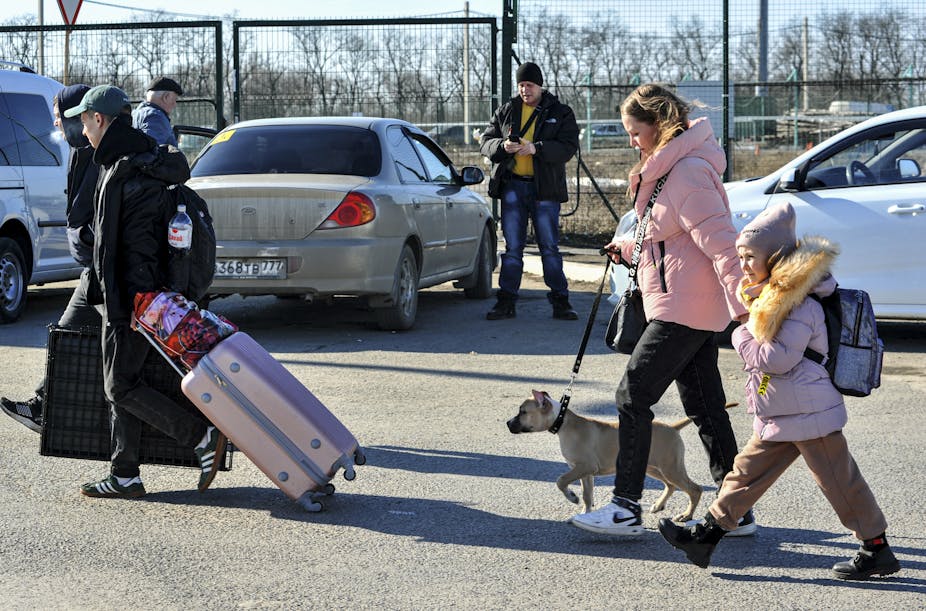Russia’s recognition of the Donetsk and Luhansk People’s Republics, and fears of a military attack on Ukraine, have once again drawn the world’s attention to these two rebel-held separatist regions. They have been outside Ukrainian government control since Russian-backed separatists fought Ukrainian forces to a standstill in 2014, a conflict that has killed some 14,000 people. While an estimated two million have fled these territories – mainly to either Russia or Ukraine – about three million have remained. In the past few days, women and children in these regions have been ordered to evacuate to Russia, indicating armed conflict is again upending their lives.
In July 2021, we hired a Ukraine-based research team to help us conduct focus groups with people living in the separatist territories about the everyday problems they faced. In contrast to journalists, who tend to seek out people with especially interesting stories to interview, we sought to recruit a selection of ordinary people, including both urban and rural residents, men and women. Overall, 40 people participated, and despite the virtual format they seemed quite comfortable discussing aspects of their daily lives, usually from their own living rooms.
We were struck above all by what they did not talk about: whether they wished to be part of Russia, part of Ukraine or independent of both. While the Russian and Ukrainian governments have jockeyed for eight years now over these territories, these residents were more concerned with daily problems. They struggled with COVID quarantines, feeding their families, obtaining education for their children, and staying in touch with relatives across the “line of contact” – the border between the areas controlled by the Ukrainian government and the separatist territories.
In 2015, the Minsk II agreement led to a ceasefire between the separatists in Donetsk and Luhansk and the Ukrainian government. Since then, these regions have been controlled by Russian-backed puppet governments. The isolation has taken its toll on the people living there. Some of our participants had lost jobs or businesses, and many complained of rising prices and falling wages. The banking system was cut off from the outside world, the transport system deteriorated, pensions were no longer paid, and a 10 pm curfew restricted their evening movements. Residents were separated from relatives in Ukraine, from siblings who had moved to Russia, and their children could no longer visit their grandparents.
Many lamented the sharp decline in the region’s population, noting that most of those who remained were older than 40. According to official estimates, 41% of the population in the separatist territories is over 65, higher than elsewhere in Ukraine. Many young people had left for Ukraine or Russia, “because what prospects do they have? None.” Most of the infrastructure has been broken or closed – mines, enterprises, and factories. Many of the best specialists, medical staff and doctors have left. One father angrily recounted how he took his child to get an injection and the medical technician didn’t even know how to get blood out of the child’s finger.
Asked how the conflict affects their lives, they responded with expletives, not words. Although caught in the middle of the conflict, they felt abandoned by both sides: “We are not needed there, and we are not needed here.” Some noted that the sporadic shooting they still hear at night makes their children cry and triggers traumatic memories of the days of fully fledged fighting.

While the predominant view of our participants was to see the separatist territories as empty, isolated and lethargic, there were some expressions of optimism. The centre of Donetsk – once a thriving city, Ukraine’s fifth largest – had recently improved, with new roads and amenities. Some had moved into empty houses in the centre and described activities for children and public events. Nonetheless, most of our participants were deeply pessimistic:
At the beginning of the conflict, there was money, savings and hope. Now the savings are finished, and the hope is finished.
Choosing to stay
Why did these people stay in conditions that so many of their friends and neighbours had left? Not (as the Russian government claims) because they wished to be part of Russia or because of any political commitments, but because they had no job opportunities elsewhere, funds for relocating, or networks to help them start over. Responsibilities such as small children or elderly parents tied them to the region. And departing would mean abandoning their homes. Leaving into the unknown felt worse than staying put. As one person put it:
If there is no light in the tunnel, then there is nowhere to go.
With the heated rhetoric surrounding these regions on the geopolitical stage, we were surprised by the lack of either pro-Russian or pro-Ukrainian comments in our focus groups. Pro-Russian ideologues may have declined to participate in groups organised by a Kyiv-based research organisation, and participants may have self-censored for fear of reprisal.
International conversations about these regions and other “frozen” conflicts often treat the residents of such regions as political pawns. But their true concerns often have more to do with everyday life in unstable, chaotic and often threatening circumstances, where infrastructure has been destroyed by fighting and government has abandoned them. The separatist territories have become desolate, sad places, without hope or opportunity.
As one respondent said, “We are slowly dying out.” A new Russian invasion will only hasten the process.


